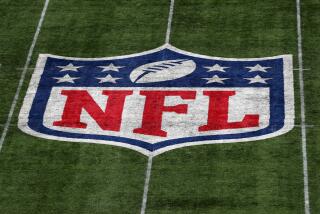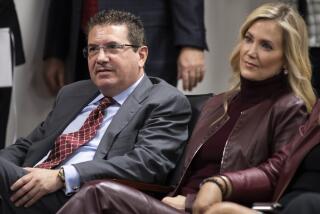NFL players’ union decertifies; owners institute lockout
The union representing NFL players pushed away from the negotiating table and decertified Friday, an extreme measure that leaves the federal courts to determine the future of the nation’s most popular sports league.
By decertifying — dissolving itself as a union — the NFL Players Assn. has cleared the way for individual players to file antitrust lawsuits against the league, which could be barred from locking out those players. According to multiple reports, however, the league officially instituted a lockout after midnight on the East Coast.
In the immediate aftermath of decertification, a group of players that included three of the NFL’s most popular quarterbacks — Tom Brady, Peyton Manning and Drew Brees — filed an antitrust lawsuit against the league in U.S. District Court to prevent a lockout. The players allege that the NFL conspired to deny their ability to market their services.
The NFL and NFLPA participated in 17 days of sessions with a federal mediator, twice extending the expiration deadline of the collective bargaining agreement, but failed to strike a deal.
“We believe that ultimately this is going to be negotiated at the negotiating table,” NFL Commissioner Roger Goodell said. “They’ve decided to pursue another strategy and that is their choice. But we are prepared to negotiate an agreement that is fair to the players and fair to the clubs.”
One sticking point has been the NFL’s resistance to releasing complete financial data on its teams, information it doesn’t even share among clubs. The league said it was willing to share more financial information with the players than it ever has. The players argue that if they’re being asked to give more money to the owners — in addition to the $1 billion taken off the top before revenues are divided —– they should be privy to the books.
About 15 minutes before decertifying, the union offered to extend the CBA expiration deadline — but only if the NFL provided audited financial statements for the last 10 years.
“As businessmen, we asked the owners two years ago to consider two basic tenets to getting a fair deal: financial transparency and the health and safety of our players,” DeMaurice Smith, NFLPA executive director, said in a written statement several hours after decertification. “Financial transparency would help us reach a compromise. Even until the last moment, we were rebutted.”
The NFLPA has transitioned into a voluntary trade association with no authority to negotiate for the players. Now, labor lawyer Jeffrey Kessler will take the lead on behalf of the players.
The NFL and NFLPA are fighting over how to divide the league’s $9 billion in annual revenues. Labor peace has been a cornerstone of a league that hasn’t had a player work stoppage since the 1987 season. Every other major U.S. professional sports league has had either a strike or lockout in the interim.
New York Giants owner John Mara, who attended several days of discussions between the sides at the Federal Mediation and Conciliation Service offices in Washington, D.C., said the union’s position on the core economic issues never changed “one iota” either before or during the 16 mediation sessions. Mara said the union’s position since September was, “Take it or leave it.”
“One thing that became painfully apparent to me during this period was that their objective was to go the litigation route,” Mara said. “I think that they believe that that gives them the best leverage. I never really got the feeling during the past two weeks that they were serious about negotiating, and it’s unfortunate because that’s not what collective bargaining is all about.”
The NFL was initially asking for players to give back an additional $1 billion off the top, before revenues were divided 60-40 in favor of the players. The league said it reduced that request in negotiations and “more than split the economic difference” between the sides.
The league released what it described as a summary of its proposal to the players:
•An entry level compensation system based on the union’s “rookie cap” proposal, rather than the wage scale proposed by the clubs. Under the NFL proposal, players drafted in rounds 2-7 would be paid the same or more than they are paid today. Savings from the first round would be reallocated to veteran players and benefits.
A guarantee of up to $1 million of a player’s salary for the contract year after his injury, the first time that the clubs have offered a standard multiyear injury guarantee.
A reduction in the off-season program by five weeks, reducing OTAs (Organized Training Activities) from 14 to 10, and limiting on-field practice time and contact; limiting full-contact practices in the preseason and regular season, and increasing the number of days off for players.
Committing that any change to an 18-game season would be made only by agreement and that the 2011 and 2012 seasons would be played under the current 16-game format.
Owner funding of $82 million in 2011-12 to support additional benefits to former players, which would increase retirement benefits for more than 2,000 former players by nearly 60%.
Current players offered the opportunity to remain in the player medical plan for life.
Third-party arbitration for appeals in the drug and steroid programs.
Improvements in the “Mackey Plan” (designed for players suffering from dementia and other brain-related problems), disability plan and degree completion bonus program.
A per-club cash minimum expenditure of 90% of the salary cap over three seasons.
The NFLPA, in turn, listed reasons why no new CBA was reached, saying the NFL:
Demanded a multibillion-dollar giveback and refused to provide any legitimate financial information to justify it.
Wanted to turn the clock back on player compensation by four years, moving them back to where they were in 2007.
Offered no proposal for long-term share of revenues.
Demanded 100% of all revenues that went above unrealistically low projections for the first four years.
Refused to meet the players on significant changes to in-season, off-season or pre-season health and safety rules.
Kept on the table its “hypocritical” demand for an 18-game season, despite its public claims to be working toward improving the heath and safety of players.
Wanted cutbacks in workers’ compensation benefits for injured players.
Sought to limit rookie compensation long after they become veterans — into players’ fourth and fifth years.
twitter.com/latimesfarmer
More to Read
Go beyond the scoreboard
Get the latest on L.A.'s teams in the daily Sports Report newsletter.
You may occasionally receive promotional content from the Los Angeles Times.











